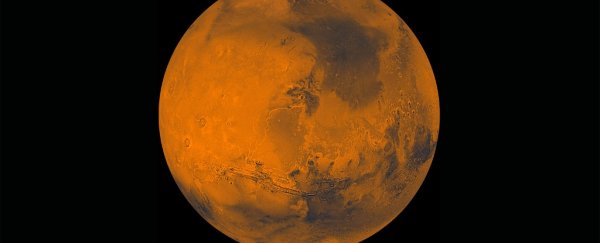The slope rises as high as London's Big Ben tower. Beneath its ruddy layer of dirt is a sheet of ice 300 feet (90 metres) thick that gives the landscape a blue-black hue. If such a scene sounds otherworldly, it is. To visit it, you'll have to travel to Mars.
Planetary scientists located eight of these geological features, called scarps, on the Red Planet. An analysis of the scarps revealed that thick ice hides just below the surface.
This ice, the researchers say, could be a tempting target for future exploration - as well as a valuable resource for Earthlings camped out on Mars.
"We've found a new window into the ice for study, which we hope will be of interest to those interested in all aspects of ice on Mars and its history," said Colin Dundas, a member of the US Geological Survey's Astrogeology Science Center in Arizona and an author of a report published Thursday in the journal Science.
It is not news that Mars is icy. In 2001, the Mars Odyssey spacecraft arrived at the planet and began snooping for chemical signatures of ice.
The craft's gamma-ray spectrometer found telltale hydrogen, which indicated Mars had enormous amounts of ice. As much as a third of the Martian surface contains shallow ice.
But remotely sensing elements such as hydrogen could not reveal the depth and makeup of the ice.
The newer Mars Reconnaissance Orbiter mapped the surface in greater detail. Dundas and his colleagues used its pictures to locate exposed ice in small craters, glaciers and ice sheets.
"The high-resolution data has greatly improved our understanding of various ice-related land forms," he said.
These cliffs are "rare peeks into the subsurface of Mars, giving us access to an undisturbed slice through Mars's ice in the mid-latitudes - a fantastic find!" said Susan Conway, a planetary scientist at the University of Nantes in France who was not involved with this research.
 A colour-enhanced scarp on Mars, showing the icy region in blue. (NASA/JPL/University of Arizona/USGS)
A colour-enhanced scarp on Mars, showing the icy region in blue. (NASA/JPL/University of Arizona/USGS)Open University's Matt Balme, a planetary scientist in Britain who did not participate in this study, said the key findings were the colour images of a bluish tint.
That indicates a sub-layer that is "somehow compositionally different" than the red dirt. It is unlikely that the frozen sheets are a mix of water and soil.
"If the conclusions of the paper are correct," he said, "you're looking at something that's almost pure ice."
The scarps exist along the planet's middle latitudes, ruling out glaciers that migrated from the poles. The study authors propose that these ice sheets formed when thick snows blanketed Mars.
Balme agreed that snowfall probably created the ice over a period of a few thousand years.
"We considered the possibility that we were seeing surface frost," Dundas said, "but the ice signatures persist through the summer."
The buried ice revealed itself after the structures became unstable and expanded. Those cliffs formed through a process called sublimation, in which exposed ice turned directly into water vapor. Boulders and dust that rested on the ice suddenly had their foundation vanish into the atmosphere.
These slopes are unusually steep, Balme said, though he imagines that the scarps look similar to glacial moraines on Earth.
The sheets' proximity to the surface makes them accessible, in theory, to robot explorers.
"This subsurface ice could contain valuable records of the Martian climate, just like the Greenland and Antarctic ice cores," Conway said.
In August, geochemists obtained 2.7-million-year-old ice samples from Antarctica - the oldest ever - and they plan to study air bubbles trapped within them to learn about Earth's prehistoric atmosphere.
And flesh-and-blood explorers might benefit, too (though the middle latitudes of Mars appear to be colder, less welcoming terrain than regions closer to the equator).
"If we were to send humans to live on Mars for a substantial period of time, it would be a fantastic source of water," Balme said. Astronauts living in the pits would have a vital raw material next door.
All a thirsty astronaut would have to do would be to go at the scarp with a hammer and, presto, fresh Martian ice chips.
2017 © The Washington Post
This article was originally published by The Washington Post.
